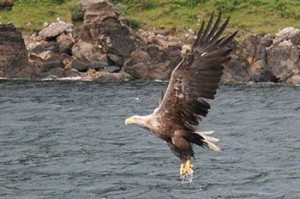
A PROJECT to reintroduce sea eagles to Scotlandhas been criticised amid evidence young chicks are struggling to cope with Scottish rain.
Several of the rare birds of prey, born in Norway and released in east Scotland by the Royal Society for the Protection of Birds (RSPB) have been found close to death after bouts of bad weather.
The birds, famed for wingspans of 8ft, were grounded when their wings became waterlogged with rain.
It meant they could not fly or hunt for food, and there are fears they are struggling to adapt to their environment.
According to the Scottish Society for the Prevention of Cruelty to Animals (SSPCA), nine sea eagles have been rescued since last year, including five that were exhausted and weak after heavy rain.
Two birds recently found in Fife would have died without human intervention, the charity said.
This has raised concerns that hand-reared sea eagles releases into the wild in Scotland are ‘naive’ and lack key survival instincts, such as heading for shelter in bad weather.
It also raises the possibility that birds in more remote locations have perished in bad weather.
Since 2007, more than 60 white-tailed sea eagles have been introduced to east Scotland to re-establish numbers of the rare species.
The project was awarded £235,000 last July by the Heritage Lottery Fund.
“We’d never had a sea eagle until last year,” said a spokesman for the SSPCA. “The two-white-tailed sea eagles we recently rescued could have perished without intervention but luckily they were found in time. They were exhausted and in need of feeding.
“Almost all the sea eagles that have come into our care in this condition are youngsters who have been reintroduced so it’s likely to be because they are naive and don’t have the experience of older birds or birds that were hatched in the wild to take cover in severe weather.”
Affectionately known as ‘flying barn doors’ due to their wing span, white-tailed eagles were only re-introduced to Scotland in 1975 having previously been wiped out by humans.
The last British white-tailed eagle, the country’s largest bird of prey, was shot in 1918.
Struggling
Two formal reintroductions, releasing a total of 140 birds, were carried out on Rum and Wester Ross between 1975 and 1998.
However, the RSPB’s decision to release further individuals in the east has been criticised as unnecessary.
The project has also faced opposition from farmers and crofters who say the birds attack and kill livestock.
Jonnie Hall, director of policy and regions at farming union NFU Scotland said: “We have always said that the east coast reintroduction is a forced expansion of the sea eagles.
“There is a well-established west coast population and they should be allowed to expand naturally rather than dumping young birds in the east of Scotland.
“The RSPB are trying to force the expansion and it’s backfiring. The birds are clearly struggling to cope with the combination of bad weather and the environment.”
The SSPCA said rescued sea eagles are among more than 1,550 wild birds saved this year.
In four years the number of wild birds rescued and released by the SSPCA has more than trebled, from 441 in 2007 to 1,472 in 2010.
They include hundreds of displaced swans and orphaned cygnets with injuries from fishing hooks and wire, while others were attacked by dogs or rival swans, shot with airguns or hit by vehicles.
The charity intends to open a new national wildlife rescue centre early next year to cope with the rising numbers of sick and injured animals.
A spokesman for RSPB Scotland defended the reintroduction of sea eagles and pointed to a report which found that white-tailed sea eagles bring at least £5m to the Mull economy every year

